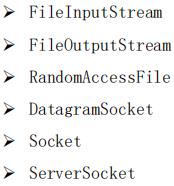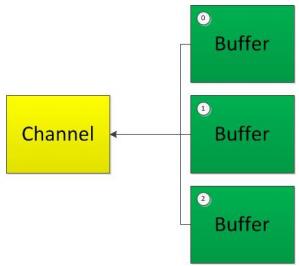4.NIO_Channel 通道
Posted QueryMarsBo
tags:
篇首语:本文由小常识网(cha138.com)小编为大家整理,主要介绍了4.NIO_Channel 通道相关的知识,希望对你有一定的参考价值。
1.通道(Channel)
由 java.nio.channels 包定义的。Channel 表示 IO 源与目标打开的连接。Channel 类似于传统的“流”。只不过 Channel
本身不能直接访问数据,Channel 只能与Buffer 进行交互
Java 为 java.nio.channels.Channel 接口提供的最主要实现类如下:
1. FileChannel:用于读取、写入、映射和操作文件的通
2. DatagramChannel:通过 UDP 读写网络中的数据通道
3. SocketChannel:通过 TCP 读写网络中的数据
4. ServerSocketChannel:可以监听新进来的 TCP 连接,对每一个新进来的连接都会创建一个 SocketChannel
1.获取通道
1.Java 针对支持通道的类提供了 getChannel() 方法

2.在 JDK 1.7 中的 NIO.2 针对各个通道提供了静态方法 open(),打开并返回指定通道
3.获取通道的其他方式是使用 Files 类的静态方法 newByteChannel() 获取字节通道
2.通道的数据读取:
1. 从 Channel 读取数据到 Buffer:int bytesRead = inChannel.read(buf);
2. 将 Buffer 中数据写入 Channel:int bytesWritten = inChannel.write(buf);
3.通道之间的数据传输:
transferFrom():将数据从源通道传输到其他 Channel 中:
transferTo():将数据从源通道传输到其他 Channel 中
4.分散(Scatter)和聚集(Gather):
分散读取(Scattering Reads)是指从 Channel 中读取的数据“分散”到多个 Buffer 中

注意:按照缓冲区的顺序,从 Channel 中读取的数据依次将 Buffer 填满
聚集写入(Gathering Writes)是指将多个 Buffer 中的数据“聚集”到 Channel

注意:按照缓冲区的顺序,写入 position 和 limit 之间的数据到 Channel
4.例子代码:
package cn.nio; import java.io.FileInputStream; import java.io.FileOutputStream; import java.io.IOException; import java.io.RandomAccessFile; import java.nio.ByteBuffer; import java.nio.CharBuffer; import java.nio.MappedByteBuffer; import java.nio.channels.FileChannel; import java.nio.channels.FileChannel.MapMode; import java.nio.charset.CharacterCodingException; import java.nio.charset.Charset; import java.nio.charset.CharsetDecoder; import java.nio.charset.CharsetEncoder; import java.nio.file.Paths; import java.nio.file.StandardOpenOption; import java.util.Map; import java.util.Map.Entry; import java.util.Set; import org.junit.Test; /* * 一、通道(Channel):用于源节点与目标节点的连接。在 Java NIO 中负责缓冲区中数据的传输。Channel 本身不存储数据,因此需要配合缓冲区进行传输。 * * 二、通道的主要实现类 * java.nio.channels.Channel 接口: * |--FileChannel * |--SocketChannel * |--ServerSocketChannel * |--DatagramChannel * * 三、获取通道 * 1. Java 针对支持通道的类提供了 getChannel() 方法 * 本地 IO: * FileInputStream/FileOutputStream * RandomAccessFile * 网络IO: * Socket * ServerSocket * DatagramSocket * * 2. 在 JDK 1.7 中的 NIO.2 针对各个通道提供了静态方法 open() * 3. 在 JDK 1.7 中的 NIO.2 的 Files 工具类的 newByteChannel() * * 四、通道之间的数据传输 * transferFrom():将数据从源通道传输到其他 Channel 中: * transferTo():将数据从源通道传输到其他 Channel 中 * * 五、分散(Scatter)与聚集(Gather) * 分散读取(Scattering Reads):将通道中的数据分散到多个缓冲区中 * 聚集写入(Gathering Writes):将多个缓冲区中的数据聚集到通道中 * * 六、字符集:Charset * 编码:字符串 -> 字节数组 * 解码:字节数组 -> 字符串 * */ public class TestChannel { //字符集 @Test public void test6() throws IOException{ //指定编码方式 Charset cs1 = Charset.forName("GBK"); //获取编码器 CharsetEncoder ce = cs1.newEncoder(); //获取解码器 CharsetDecoder cd = cs1.newDecoder(); CharBuffer cBuf = CharBuffer.allocate(1024); cBuf.put("威武!"); cBuf.flip(); //编码 ByteBuffer bBuf = ce.encode(cBuf); for (int i = 0; i < 12; i++) { System.out.println(bBuf.get()); } //解码 bBuf.flip(); CharBuffer cBuf2 = cd.decode(bBuf); System.out.println(cBuf2.toString()); System.out.println("------------------------------------------------------"); Charset cs2 = Charset.forName("GBK"); bBuf.flip(); CharBuffer cBuf3 = cs2.decode(bBuf); System.out.println(cBuf3.toString()); } //遍历所有的字符集 @Test public void test5(){ Map<String, Charset> map = Charset.availableCharsets(); Set<Entry<String, Charset>> set = map.entrySet(); for (Entry<String, Charset> entry : set) { System.out.println(entry.getKey() + "=" + entry.getValue()); } } //分散和聚集 @Test public void test4() throws IOException{ RandomAccessFile raf1 = new RandomAccessFile("C:/sss.txt", "rw"); //1. 获取通道 FileChannel channel1 = raf1.getChannel(); //2. 分配指定大小的缓冲区 ByteBuffer buf1 = ByteBuffer.allocate(100); ByteBuffer buf2 = ByteBuffer.allocate(1024); //3. 分散读取 ByteBuffer[] bufs = {buf1, buf2}; //将通道中的数据分散到多个缓冲区中:从 Channel 读取数据到 Buffer channel1.read(bufs); for (ByteBuffer byteBuffer : bufs) { byteBuffer.flip(); } System.out.println(new String(bufs[0].array(), 0, bufs[0].limit())); System.out.println("-----------------"); System.out.println(new String(bufs[1].array(), 0, bufs[1].limit())); //4. 聚集写入 RandomAccessFile raf2 = new RandomAccessFile("C:/2.txt", "rw"); FileChannel channel2 = raf2.getChannel(); //将 Buffer 中数据写入 Channel channel2.write(bufs); } //通道之间的数据传输(直接缓冲区) @Test public void test3() throws IOException{ FileChannel inChannel = FileChannel.open(Paths.get("d:/1.mkv"), StandardOpenOption.READ); FileChannel outChannel = FileChannel.open(Paths.get("d:/2.mkv"), StandardOpenOption.WRITE, StandardOpenOption.READ, StandardOpenOption.CREATE); //inChannel.transferTo(0, inChannel.size(), outChannel); outChannel.transferFrom(inChannel, 0, inChannel.size()); inChannel.close(); outChannel.close(); } //使用直接缓冲区完成文件的复制(内存映射文件)(支持byteBuffer) @Test public void test2() throws IOException{//2127-1902-1777 long start = System.currentTimeMillis(); //Paths工具类, FileChannel inChannel = FileChannel.open(Paths.get("C:/sss.txt"), StandardOpenOption.READ); //完成文件的复制,StandardOpenOption.CREATE文件存在与否,都创建 FileChannel outChannel = FileChannel.open(Paths.get("C:/xxx.txt"), StandardOpenOption.WRITE, StandardOpenOption.READ, StandardOpenOption.CREATE); //创建内存映射文件:直接字节缓冲区还可以通过 FileChannel 的 map() 方法 将文件区域直接映射到内存中来创建,不需要通道,直接操作缓冲区 MappedByteBuffer inMappedBuf = inChannel.map(MapMode.READ_ONLY, 0, inChannel.size()); MappedByteBuffer outMappedBuf = outChannel.map(MapMode.READ_WRITE, 0, inChannel.size()); //直接对缓冲区进行数据的读写操作 byte[] dst = new byte[inMappedBuf.limit()]; //批量读取多个字节到 dst 中 inMappedBuf.get(dst); //利用 put() 存入数据到缓冲区中 outMappedBuf.put(dst); inChannel.close(); outChannel.close(); long end = System.currentTimeMillis(); System.out.println("耗费时间为:" + (end - start)); } //利用通道完成文件的复制(非直接缓冲区) @Test public void test1(){//10874-10953 long start = System.currentTimeMillis(); FileInputStream fis = null; FileOutputStream fos = null; //①获取通道 FileChannel inChannel = null; FileChannel outChannel = null; try { fis = new FileInputStream("C:/sss.txt"); fos = new FileOutputStream("C:/ddd.txt"); inChannel = fis.getChannel(); outChannel = fos.getChannel(); //②分配指定大小的缓冲区 ByteBuffer buf = ByteBuffer.allocate(1024); //③将通道中的数据存入缓冲区中 while(inChannel.read(buf) != -1){ //切换读取数据的模式 buf.flip(); //④将缓冲区中的数据写入通道中 outChannel.write(buf); buf.clear(); //清空缓冲区 } } catch (IOException e) { e.printStackTrace(); } finally { if(outChannel != null){ try { outChannel.close(); } catch (IOException e) { e.printStackTrace(); } } if(inChannel != null){ try { inChannel.close(); } catch (IOException e) { e.printStackTrace(); } } if(fos != null){ try { fos.close(); } catch (IOException e) { e.printStackTrace(); } } if(fis != null){ try { fis.close(); } catch (IOException e) { e.printStackTrace(); } } } long end = System.currentTimeMillis(); System.out.println("耗费时间为:" + (end - start)); } }
以上是关于4.NIO_Channel 通道的主要内容,如果未能解决你的问题,请参考以下文章